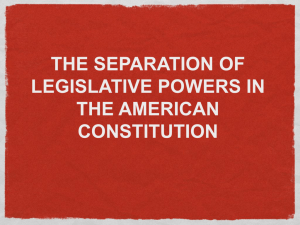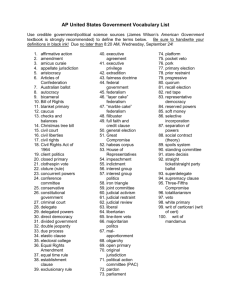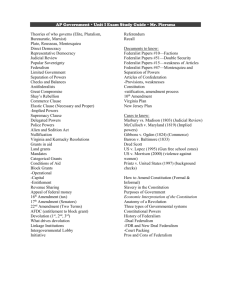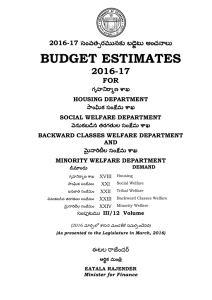Review Sheet Chapter 4
advertisement
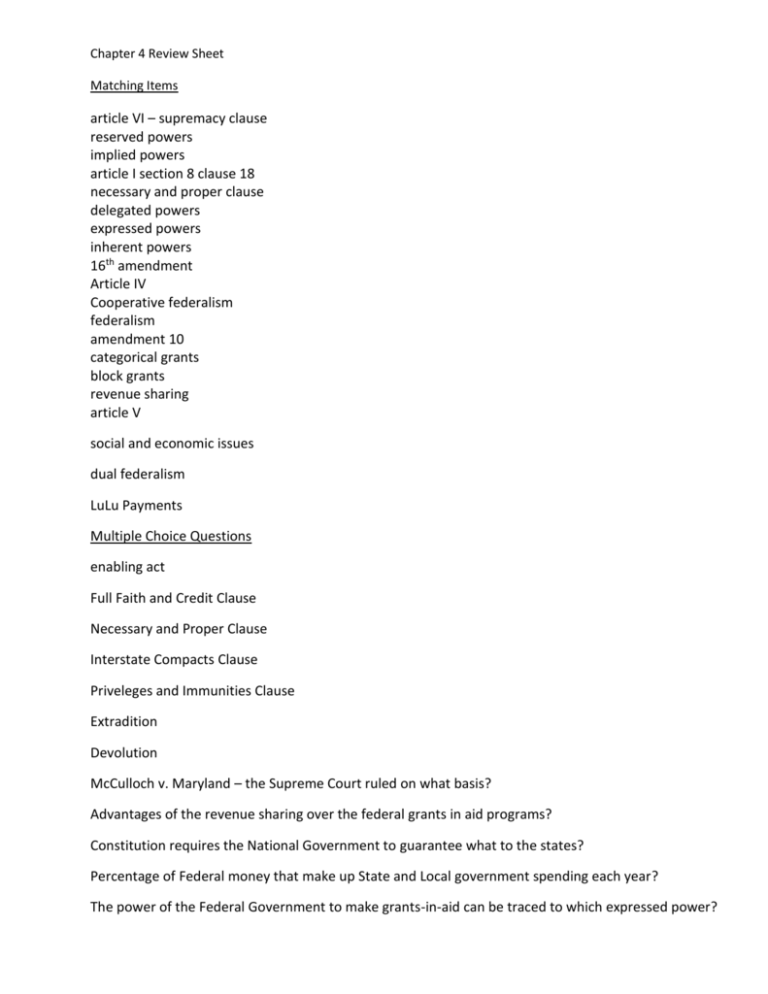
Chapter 4 Review Sheet Matching Items article VI – supremacy clause reserved powers implied powers article I section 8 clause 18 necessary and proper clause delegated powers expressed powers inherent powers 16th amendment Article IV Cooperative federalism federalism amendment 10 categorical grants block grants revenue sharing article V social and economic issues dual federalism LuLu Payments Multiple Choice Questions enabling act Full Faith and Credit Clause Necessary and Proper Clause Interstate Compacts Clause Priveleges and Immunities Clause Extradition Devolution McCulloch v. Maryland – the Supreme Court ruled on what basis? Advantages of the revenue sharing over the federal grants in aid programs? Constitution requires the National Government to guarantee what to the states? Percentage of Federal money that make up State and Local government spending each year? The power of the Federal Government to make grants-in-aid can be traced to which expressed power? The Three Videos we watched: Fill in the blank questions 1. Federal Wolves at the Door This story highlights the federal Endangered Species Act, passed by Congress in 1973, which imposes federal mandates on states to protect animal species that are deemed in danger of becoming extinct. In this story, the state of Idaho is grappling with a federal mandate that says wolves, an endangered species, must be reintroduced into the state and managed by state authorities. In the end, despite protests from many Idahoans, the Idaho government realized it must comply with the national government's mandate 2. Using Federal Dollars To "Buy" Interstate Highway Safety The federal government sometimes uses grants-in-aid programs to expand into policy areas that are traditionally (and constitutionally) controlled by the states or local authorities. This story involves federal efforts to impose a national drunk driving standard, as measured by a .08 blood alcohol level, at the urging of national groups including Mothers Against Drunk Driving (MADD). In the 1980s, states were put under pressure to adopt the national standard or risk losing millions in federal highway funds. South Carolina, a state with a long tradition of resistance to federal encroachments on its authority, has yet to adopt the national standard for its citizens. The story closes in 2002, when the .08 bill died in the South Carolina State Legislature. As a result of the committee's action, the state has kept its constitutional authority to set its own standards, but it risked losing 64 million dollars in federal highway funds if it failed to adopt the national standard by 2007. When Welfare Depends on Where You Live This story explores one example of "devolution," a process where the national government reduces its authority over some issues and shifts power to the states. In 1996, President Clinton signed a welfare reform bill that provided federal funds to the states in the form of block grants, but allowed states to set their own welfare policies. Supporters of the bill, officially entitled The Personal Responsibility and Work Opportunity Reconciliation Act of 1996, hailed it as a way to allow states to determine for themselves how they should assist their citizens, while critics charged that some states were unwilling to or incapable of providing sufficient help to the people who need it most. In the first five years after the law was enacted, over one million people, mostly women, went off welfare, while welfare rolls dropped by more than 50 percent nationwide. However, the aggregate statistics don't reflect significant differences among states in how they have run their welfare programs and in how successful they are. For example, some states have reduced their welfare rolls by 90 percent, while others saw much smaller reductions.



